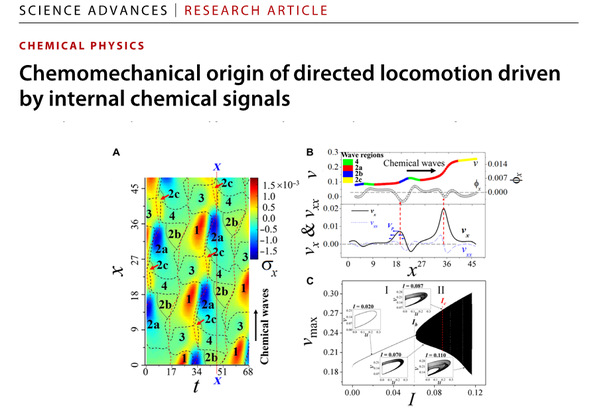CUMT Researchers Achieved New Research Progress on the Dynamics Mechanism of Directed Locomotion Driven by Bio-inspired Neural Signals
Publisher : Time : 19.June 2020 Browse the number :

Signals from the Central pattern generator (CPG) can produce rhythmic motion output in the absence of both sensory feedback and a center of higher nervous activity, has the advantages of high robustness and good adaptability. However, the chemomechanical mechanism of nerve-muscles coupling on the rhythmic motion (driven by neuronal signals) remain a challenging task.
Prof. Qingyu Gao’s research group at CUMT’s School of Chemical Engineering and Technology (SCET) working with coworkers at the University of Brandeis published a joint paper “Chemomechanical Origin of Directed Locomotion Driven by Internal Chemical Signals”, to report on this progress.
The work employs a self-oscillating gel to study the chemomechanical mechanism of the nerve-muscles coupling, in which chemical pulse waves and a stimulus-responsive medium play role analogous to nerve pulses and deformable muscles in an animal.
This group investigates an active gel (a symmetry boundary condition is adopted) that undergoes directed and rhythmic locomotion (have a bio-inspired function of CPG) in a homogeneous environment where no asymmetry is introduced into the system. Meanwhile, research results indicate that the structure and the local dynamics of the bio-inspired pulse signals determines the direction and velocities of the locomotion: the internal competition between the push and the pull effects of the pulse signals determines the net displacement of the gel, which originates from a homoclinic bifurcation of the system ultimately.
Moreover, numerical analysis uncovers an anti-fluctuation (environment noise induced random fluctuations) function of the pulse signals of the system that enables the active gel to move with good performance of robustness and adaptability.
The first author of the paper is Dr. Lin Ren, a post-doctor at the SCET. The work has been published by the journal Science Advances (2020,6,eaaz9125), a sub-journal of Science Publisher.
Source:Ji chen,School of Chemical Engenieering&Technology
Editor: Zhang yuchuan
Reviewer: Zhang zhenkang